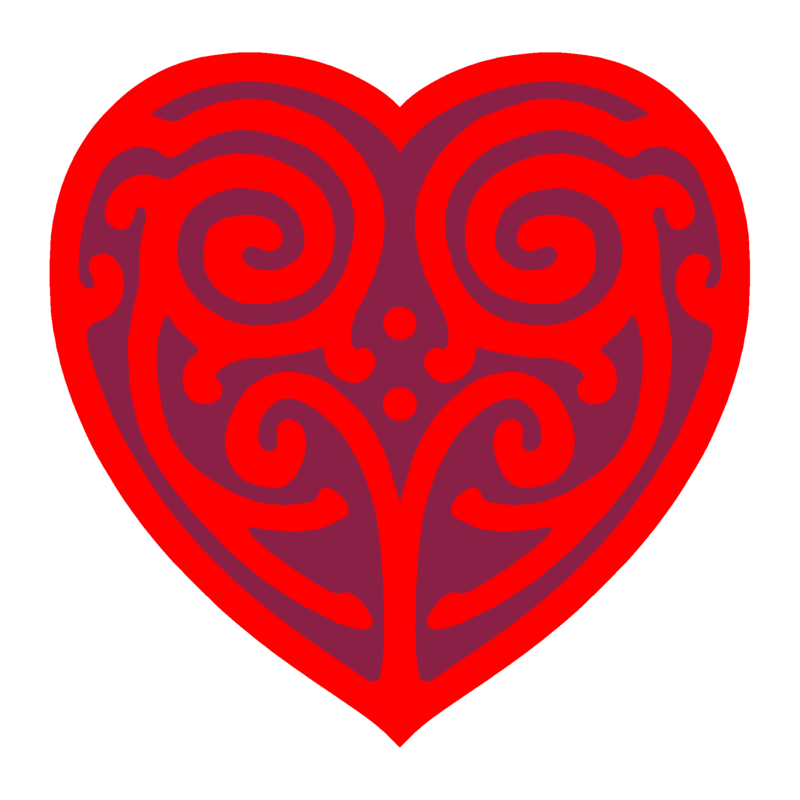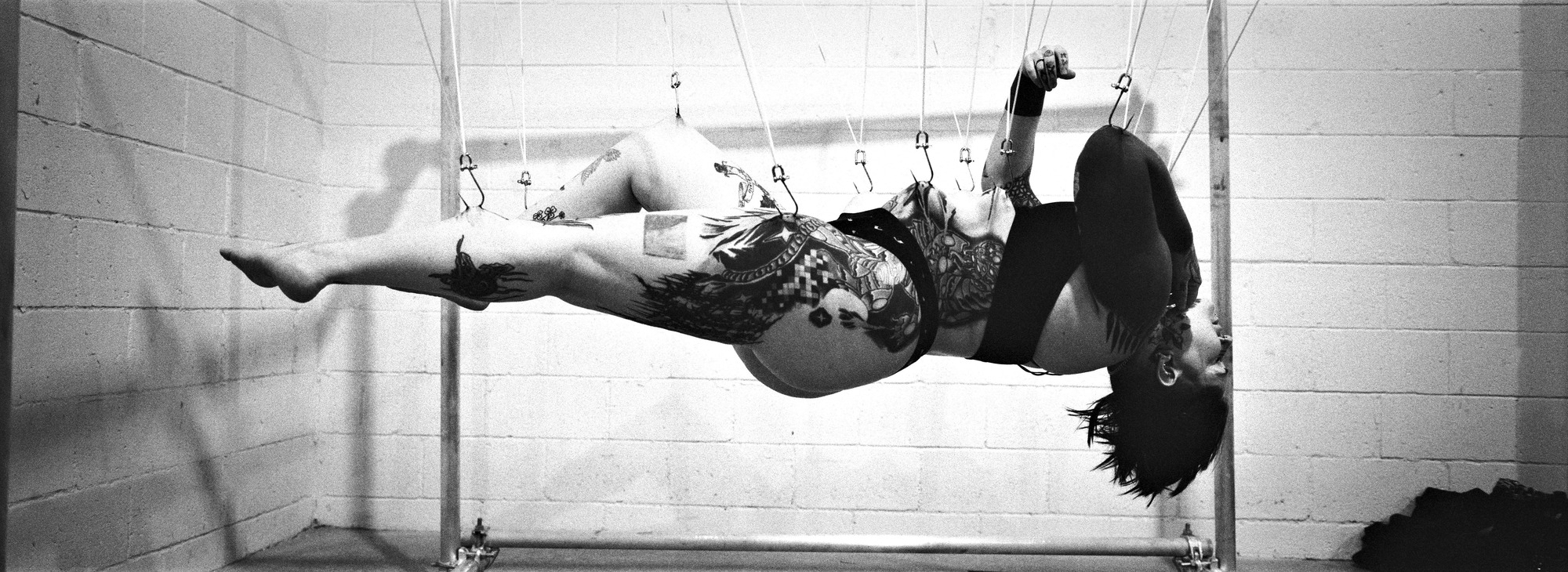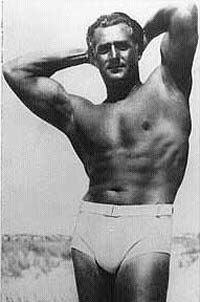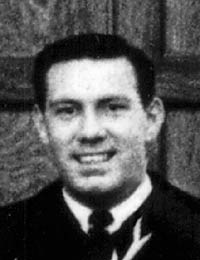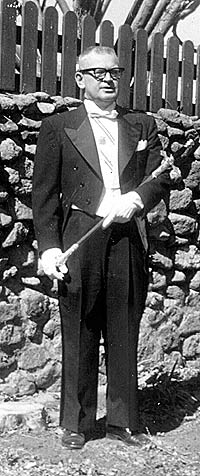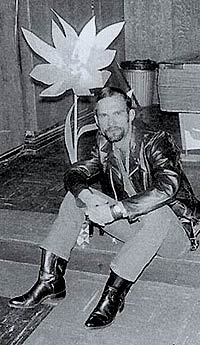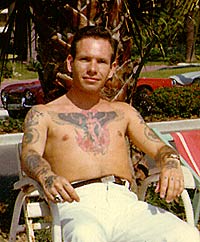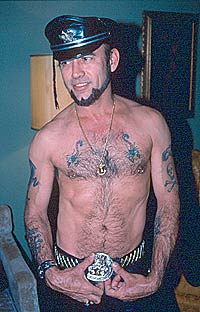
1: Who Is Jim Ward? A recent MTV documentary called me “the granddaddy of thae modern piercing movement”, in case you were wondering who I am. Maybe that gives me sufficient credentials to write a bit every now and then about the history of modern piercing and how it has evolved into what it’s become today. After all I helped create a lot of that history. Even if you never heard my name before, maybe you’ve heard of the business I started back in 1975 called Gauntlet. That business provided an outlet and a means for me to make the world aware of the wonders of piercing. In the months to come I’d like to tell you something about your roots. The modern piercing movement didn’t just suddenly happen. It evolved, and part of that evolution started with me. Not that you’re interested in my whole life story, but a little background to put it all in perspective wouldn’t be out of place. I was born in the bleakness that is Western Oklahoma six months before Pearl Harbor. Looking back on it much of my childhood was just as barren and desolate as the landscape. I couldn’t wait to escape. In the back yard of one place we lived, there was a beat up old trailer with wooden slat sides and flat tires that had long ceased to be roadworthy. I remember often climbing up to the top and looking out at the distant two-lane highway and longing to follow that road anywhere just so long as it was away from the desolation of small-town life. My parents were childhood sweethearts who eloped and secretly married shortly after they graduated from high school. The year I was born they both turned 21, perhaps a bit young to undertake the responsibilities of a family. Seldom was the rod — more often the belt — spared. They thought this would build character and assure that I wasn’t spoiled. Instead it resulted in a fearful, timid child indoctrinated with Presbyterian guilt. Years later in therapy I remembered being told, “We punish you because we love you.” Translation: punishment equals love. Not difficult to understand how S/M became rooted in my psyche! Fifth grade was my last school year in Oklahoma. My teacher was Miss Newman, a horse-faced old maid so uptight she considered “fanny” a dirty word. What I remember most vividly from that year was an incident involving one of my classmates. His name was James and he was an impish kid with a knack for getting into mischief. He and several others were in the boys’ restroom during recess one day. After finishing at the urinal he turned and demonstrated for the rest of us how his penis got bigger and harder when he stroked it. Whether or not he had any clue what that was all about I’ve no idea. I was simultaneously appalled and fascinated. Something told me this was naughty and sinful and that I should pray for him. My family moved to Colorado just in time for me to hit puberty at age eleven. Growing up in a very religious household where the subject of sex was hardly ever discussed left me totally unprepared for what was happening in my body. My mind kept flashing back to that day in the boys’ room when James had played with himself. Inevitably I had to try it myself. It felt so good I didn’t want to stop. Suddenly and unexpectedly the most incredible sensation swept over me, and, with an uncontrollable spasm, white fluid shot from my penis. Don’t ask me why, but I called that white stuff cultured piss. In retrospect it seems amazing that the whole experience didn’t freak me out. Perhaps the guilt and shame and the fear of discovery were more powerful, so powerful, in fact, that I couldn’t bring myself to tell anyone. Once the intense, guilty pleasure of masturbation had been discovered, nothing, despite my greatest efforts, could stop me from doing it for very long. Prayer didn’t help. Memorizing and reciting bible verses didn’t help. Not quite understanding why, I began to develop crushes on some of my classmates, the young men who worked as church youth counselors, and on the newly appointed youth minister. Before his conversion, one of the counselors apparently had been something of a bad boy and had gotten into trouble. He had a tattoo on one forearm, and I found myself strangely attracted to him. I wanted desperately to be close to all these guys, to please them, to be noticed by them, to…? There was an undefined longing for something for which I had no name. It was agony.
In time the burden I was carrying became unbearable, and I finally sought counsel from the church youth minister. The moment was painfully awkward, and I don’t remember how I expressed what was troubling me and I don’t recall everything that was said. I do remember Rev. Bill telling me there were three kinds of sexual expression: between a man and woman, between two men (for some reason he didn’t think to include two women), and masturbation. His mention of male/female sex elicited no response. It’s possible mention of the male/male thing made me pale or blush. I don’t know, but it probably wasn’t difficult to see how uncomfortable I was when he got around to masturbation. His counsel was low-key, and frankly I don’t recall much about it. He did take the time at least to enlighten me on the basics of sexual intercourse.
I lost contact with Rev. Bill. His proclivities eventually got him into trouble. He ended up marrying a woman some said was old enough to be his mother — I don’t recall if he ever had a child — and moved to a church in the Seattle area. Some years later I learned he had died of AIDS. As my high school years were drawing to a close, I became increasingly hostile to the religion of my family. My best friend, with whom I had done some sexual experimentation, was an Episcopalian. I began going to church with him and eventually became a member. The Episcopal Church was in a little tourist town called Manitou Springs. Across the street from it was a very nice little gift shop that didn’t sell the usual tacky souvenirs. Instead it was a place to find beautiful local crafts plus fine china, glassware and the like. John, the owner, was quick to spot a young gay man, and discovering my lack of experience, set about introducing me into the local gay community, such as it was in 1959. I worked for John that summer and was taken under the wing of a kindly older gentleman named Frank who introduced me to the various expressions of gay sex, at least the non-kinky variety. I was beginning to discover myself.
For several years after high school graduation I bounced back and forth from one school to another trying to find a vocation, but was so emotionally fucked up I couldn’t stick with anything. The mid-to-late 60s found me in New York working in various design-related jobs. Two things were noteworthy about this period, for they would have a significant bearing upon the establishing of Gauntlet. First, I took a number of classes in jewelry making. Second, I discovered the world of gay S/M and piercing. From the onset of puberty my masturbatory fantasies always involved S/M. When I jacked off I would frequently experiment with various kinds of bondage. I also discovered that intense nipple work was a big turn on and began experimenting with all kinds of clamps. The year was 1967, and I was living in Brooklyn Heights in an ancient brownstone apartment building at the foot of Joralemon Street known to the local gays as Vaseline Flats because of the sexual orientation of many residents. From my bathroom window I could look down on the Brooklyn Queens Expressway and the East River. A few blocks away on Montague Street, two gay guys, Steve and Marc, had opened a small bookstore. A friendship developed. As we became better acquainted, they disclosed that they were members of the New York Motor Bike Club, a group of gay men into leather and S/M. Here was my opportunity to explore that side of my personality that I had kept secret for so long. I felt much like I did when I discovered I was gay and that I wasn’t alone. There were others who shared the same drives and longings. In the mid-60s the gay S/M scene was nothing like it is today. Things were far from codified. No one had ever heard of safe words. It wasn’t even clear whether wearing ones keys on the left meant you were a top or a bottom and vice versa. On the East Coast it was said it meant you were a top, but if you were from the West Coast it meant you were a bottom. The bandana color code was still several years in the future. Just how much actual S/M was going on is hard for me to say. In my own experience what passed for S/M was mostly rough sex with a little role playing and bondage thrown in on occasion.
My next stop was a Western wear store where I purchased a pair of Levi’s, a pair of Wellington boots, and a black cowboy hat. Having grown up in orthopedic shoes I expected the boots to be uncomfortable, but to my amazement they weren’t. With my purchases in hand I could hardly wait to get back to my apartment. I immediately took off all my clothes, put on the boots and jacket, and jacked off in front of a mirror, the feel and smell of the leather fueling my lust. It felt like a rite of passage. I was finally becoming myself. About this time I read a magazine article about a man who had made an extensive sea voyage. To mark the occasion he had had his ear pierced. Reading this article triggered something in my psyche. I simply had to have an ear pierced. It didn’t matter that it was 1967, and most men didn’t wear earrings. This was just something I had to do.
The New York Motorbike Clubhouse was a storefront near the foot of Christopher Street, a short distance from the docks and the leather bars. With Steve and Marc’s sponsorship, I joined NYMBC and made friends with a number of the members. One of them was a man named Ron. Ron had been a merchant seaman and had the tattoos to go with the profession. Even his earlobes were tattooed with stars, in the middle of which were piercings. His tattoos and pierced ears turned me on, and led us to share some sexual exploits. We ended up as good buddies. It was natural that when I made the decision to have an ear pierced, I asked Ron to do it. One weekend we got together and Ron pierced my ear with a large sewing needle. With a bit of maneuvering he was finally able to insert a small gold ear stud through the piercing. It was done. At the time I was working in a decorator showroom that sold tacky pictures and statuary to interior designers. Naturally I was concerned that my pierced ear would not be acceptable to my employer. Still I had to leave something in the piercing for at least six weeks until it was sufficiently healed to be able to leave it out through the work day. Every morning before I left for work I would carefully clean the piercing and put a Band-Aid over it. If anyone asked I could always say I cut myself shaving. No one ever asked. At the end of six weeks I would take the stud out before going to work and insert it again when I got home. The piercing healed and is with me today. For several years nipple play was something that I found highly erotic. I’ve no idea how it even came about, but at some point I began fantasizing about piercing my nipples and wearing gold rings in them. It was a fantasy that never ceased to turn me on, but I was afraid to actually admit it to anyone. One Saturday afternoon I even attempted to pierce my own nipples. An ex-lover of mine was a watchmaker. He had a small tool box filled with various materials that he used in his trade. Among them was a small roll of thin gold wire. I snipped a few inches of it and from it fashioned a couple of small gold rings about 3/8″ in diameter. Although I filed the ends so there would be no burrs or rough edges, they still had no closure and were way too thin for the job. At the time I had no way of knowing this was important. That fateful Saturday afternoon I took the gold rings, the cork from a bottle of wine, and a push pin and soaked them in a small dish of alcohol. After cleaning my nipples with some of the alcohol, I pressed the cork against one side, the point of the push pin on the other, and taking a deep breath forced the pin through and into the cork. It hurt, but not that badly. By this time I was sweating and feeling a bit light-headed. After lying down for a few minutes, I recovered enough to proceed. It would be necessary to remove the pin to insert the ring. When I did, the wound began to bleed a little, but fortunately not enough to be a problem. The difficult part was trying to maneuver the round ring through the straight hole. This took several harrowing minutes, but I finally succeeded. All that remained was to do the other nipple. Somehow I managed. It was a testimony to my determination that I finished. But soon afterward I freaked out a bit at what I had done and removed the rings. By the following morning, were it not for the pleasurable tenderness, I would not have known what had happened the previous day.
At this point in my life I had never seen or heard of anyone with pierced nipples even in the pages of National Geographic. That was soon to change. One weekend night I went to the Village to hang out at the NYMBC. Standing shirtless by the bar was a hunk of a man. Even in the subdued light there was no missing the glint of gold on his muscular chest. His nipples were pierced. I learned that his name was Fernando and that he was something of a local legend. Though I was never fortunate enough to enjoy the intimate pleasure of his company, he at least let me know that once again I was not alone. Next: From New York to Hollywood
|
Author: BME
-
Who is Jim Ward? [Running The Gauntlet – By Jim Ward]
Written by
-
Body Modification vs. Spirituality – Through the Modified Looking Glass
Written by
Body Modification vs. Spirituality We are not engaged in a complicated joke disguised as a new religion. We are engaged in a new religion disguised as a complicated joke.
– Malaclypse the YoungerThis column will be a little different. In terms of style, it is even more so than usual a collection of thoughts and reactions. It is very much a sort of revealing of the process and analysis which runs through my consciousness as it relates to the topics within. I present it hopefully as ‘food for thought’ because that is the sort of food which, while it cannot support life, can make living far more interesting.
I am not a religious person. I am not a spiritual person. I do not worship. I do not believe that I have a soul or spirit. I do not feel that my mind and body are in any significant way distinct from one another. I have simply decided, after research and experimentation — still ongoing of course — that the way in which I currently choose to view and functionally interact with the world does not require these things.
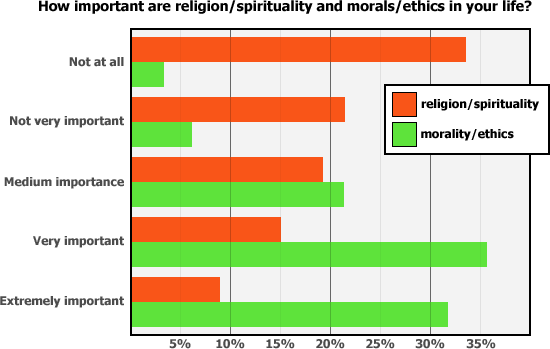
In addition, also from the BME Megasurvey, almost 90% of respondents are not a member of any religious groups involved in body modification. That leaves 10% that either have been or hope to be, although only half that number are actually currently involved in such a group.
These results left me a little bit surprised, and pleasantly so. I suppose because like many others I have been sold, to a large extent, the media version of body modification a la the modern primitive or seeker bent. I also often hear — or read on BME — about people connecting their modifications to a faith or spiritual outlook. Then again, many times it seems that the choice of terms (‘spiritual’) is very much based upon a broad and almost meaningless pop usage. Spirit derives from the Latin spiritus, meaning breath and thus breath of life. The Greek term would be psyche, standing for the principle of animation or life. These notions are most often developed in conjunction with a doctrine of soul. Broadly applied it could be related to anything regarding the experience of living, but it would generally presuppose a commitment to the idea of spirit or soul as “substance”. This idea is fundamental to many religious doctrines but also presents a host of problems so great that many thinkers have conceded dualism to be effectively bankrupt and instead try to focus on developing a notion of soul and spirit that is not separate to the body. Given the context in which the term is often placed I have to wonder if something like ‘life affirming’ might not be a less baggage-laden and equally accurate term for many to apply to their experiences.
Dualism of the mind-body, body-soul, or even mind-body-soul is to me very much like the notion of a flat earth. It has some strong intuitive appeals but eventually it fails my needs and requires unacceptable complications of explanation. I have no objections, however, to others believing in a flat earth or anything else that may suit them. When I hear ‘mind-body’ I think of it in the same relationship as, say, ‘liver-body’.
God, gods, Buddha, Allah, Vishnu, bigfoot, UFOs, leprechauns, and the Trix Rabbit — believe in whatever you would like. However, do not expect me to share your beliefs or accept your implication that my experience of life is any less vibrant or fulfilling for not sharing them. The idea that you can make qualitative judgments of other people’s experiences for them is both arrogant and absurd. While you are at it, you can attempt to convince me that the taste I detestfully experience when I eat spinach is one that is wonderful to me.
That which inspires religious or spiritual fervor in others is not missing in my life. I simply experience things through a different lens. To me such things are not evidence of the glory of a greater being or giving me contact with some universal, unifying force. They are, however, glorious life affirming experiences which further impress upon me the wonders which I can come to know.
I do not seek transcendence of body. I seek to revel in body. To me it is a marvelous and nearly unlimited thing and I am far more interested in developing it, pushing it, driving it, and ultimately exploring its full potential. I sometimes wonder if those who seek transcendence are not in some way afraid what their bodies are capable of doing, and of themselves. Is their transcendence another way of explaining experience or fleeing from the vastness of experience which is possible?
In fact, transcendence is meaningless to me. In my view of myself as a whole there is no going beyond. All is contained within. This does not mean I have any more or less than those of different views but that I explain the experiences differently. For example, I have many times experienced by induction and spontaneously all of the sensations often described as OBE (out-of-body-experience), both before and after developing my current views. I would say now that OBE is a misnomer. Of course, I don’t agree with the definition of body that is inherent in that description to begin with.
Body modification and ritual are a very large and important part of how I choose to learn about and explore my world. I have a great deal of respect for those people and cultures that have come before and continue on around me in these varied practices. They can teach me a great deal and lead me to a great many possibilities. However, I am at all times on guard to try to be aware of and separate out the necessary from the personal and cultural artifacts. Body modification describes a set of procedures and practices. They need not be religious or spiritual but can be and are often used as such. This means that the religious or spiritual component is one that is added by the individual or group as a function of their beliefs. Your experience with body modification is your own and need not involve the religious or spiritual beliefs of others. At least as careful, perhaps more so for many, as one is in choosing what foods they consume, so should one be with the ideas and beliefs one intakes.
PS. As soon as possible, for general mental nutrition, obtain and read the essay Religion for the Hell of it by Robert Anton Wilson. You can also find it re-printed in his book Coincidance. Among other things it contains the essential solution to an effective Church of Body Modification — even for us non-religious, non-spiritual types.
 Erik Sprague
Erik Sprague
because the world NEEDS freaks…
Former doctoral candidate and philosophy degree holder Erik Sprague, the Lizardman (iam), is known around the world for his amazing transformation from man to lizard as well as his modern sideshow performance art. Need I say more?
Copyright © 2003 BMEZINE.COM. Requests to republish must be confirmed in writing. For bibliographical purposes this article was first published August 14th, 2003 by BMEZINE.COM in Tweed, Ontario, Canada.
-
Body Play: State of Grace or Sickness? (Part II) – Fakir Rants & Raves
Written by


Body Play: State of Grace or Sickness?
Part II: The New Culture MaturesToday is August 10. My seventy-third birthday! It’s a good day to reflect, remember, and take stock of what has happened to me and the world around me. During the 1960s, since I’d “gone public”, I found new opportunities for personal exploration. Instead of isolation, there were now kindred spirits — others to give me encouragement and sanction for a whole new round of “body play” adventures. I asked sympathetic friends, like Davy Jones, my newly found tattoo artist, to put me in a “Kavadi” frame like that of the Savite Hindus. I was pierced by ninety four-foot long steel rods in my chest and back. I danced for many hours with this fifty-pound load. I went into a state of ecstasy and drifted out of my body. It was sweet. It was bliss. I got to know what the Tamil Hindus had experienced as long as a thousand years ago. I repeated “Taking Kavadi” many times after that, and eventually I was asked by other Modern Primitives to put them in it as well. I did so and also acted as a shaman who could safely guide them through the hazards of the “unseen worlds” to which they went.
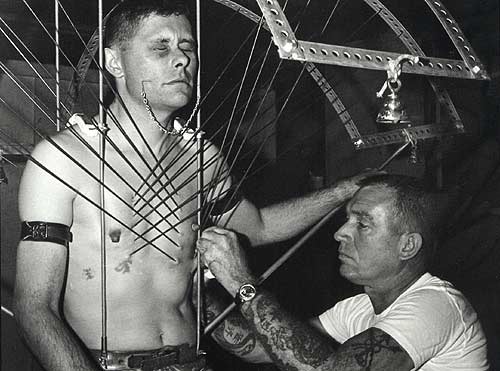
1967: TAKING KAVADI; SELF PORTRAIT WITH DAVY JONES
In another body ritual, I invited trusted friends to pierce my chest with two large hooks and suspend me by these piercings in the style of the Ogalala Sioux Sun Dance and Mandan O-Kee-Pa ceremonies. That experience proved to be truly transformative; life-altering. After I swung free it took only about ten seconds and I was lifted out of my body where I drifted up to a White Light that radiated incredible love and understanding. The Light said, “Hello, I am you and you are me. And I am as close to God as you will ever be!”
In a timeless space, I had a long telepathic conversation with the White Light. I got answers to many questions. I was never the same after that remarkable trip. Years later I discovered that many others had had a similar life-altering transformation during what is called “the near death experience”. But mine was voluntary and sought after as part of my “body play”.
I repeated the hanging several times after the first one in 1976. Each one contained its own lessons to learn and special places to visit. My fifth hanging was beautifully filmed in Wyoming for a documentary by Mark and Dan Jury, released in 1985 as Dances Sacred & Profane. A video with segments of this hanging and a Sun Dance will soon be available on my web site. I have not done this kind of suspension in recent years — one does not have to repeat a body ritual again and again if the first one resulted in a truly transformative experience. The job is done!
By 1990, the Modern Primitive Movement, with its intricate web of body expression and exploration, had come to bloom. Body piercing was now a mainstream business in large cities — mostly as a result of the diligence of a handful of people in the original 1970s T&P group mentioned in my last column. In 1990 and 1991 I worked as a commercial piercer in one of the largest of these studios in San Francisco. Since I also did, and had done for some years, private ritualized piercing I couldn’t help but introduce this element into what was developing into a commercialized personal service industry. I was curious: why did these hundreds of mostly young people flocking to our studio want piercings? I knew from years of research many of the reasons why people in other cultures did it, but how about these contemporary Modern Primitives?
In the so called “primitive” tribal societies I had studied and visited, about a dozen recurring reasons kept appearing for the practice of body piercing, marking, and modification rites:
- Rite-of-passage marking movement from one phase of life to another
- Creation of life-long peer bonding
- Sign of respect or honor for elders and ancestors
- Symbol of status, belonging, bravery, or courage
- Initiation into greater mysteries and the unseen worlds
- Protection from evil spirits and energies
- Opening for beneficial spirits and energies
- Rebalancing of body or spiritual energies
- Healing of diseased body, self, or others
- Healing of wounded psyche, self, or others
- Healing of tribal disorder and chaos
- Tribal and community connection to greater forces
Since I was now doing ten to twenty piercings a day, I had plenty of opportunity to ask reasons of contemporary piercees. In the privacy of the piercing booths we used in a commercial studio, I would encourage ritual and ask, “You don’t have to answer me if you don’t want to, but if you don’t mind, could you tell me why you’re getting your nipples pierced today?” Or, “Have you been thinking about doing this for very long? Does it have any special meaning for you?”
I expected answers like “I’m getting this because I think it’s cool” or “I want this piercing ’cause all my friends have it”.
To my surprise, most piercing clients in San Francisco gave me more meaningful answers. The reasons were not very different, in most cases, from those I had found in other cultures where body piercing was sanctioned and a part of cultural tradition… But a few of the reasons were radically skewed from those of other cultures; reasons never or seldom heard in tribal cultures. One that came up often in San Francisco, especially among young women, was a sad commentary on the abusiveness and disregard for others’ Sacred Space in our society. “I’m getting my genitals pierced today to reclaim them as my own. I’ve been used and abused. My body was taken without my consent by another. Now, by this ritual of piercing, I claim my body back. I heal my wounds.“
Some reasons were more obvious and traditional, such as the identification and status marking of certain subgroups like bikers, or the Club Fuck girls of Los Angeles who all wore small colored rings in their nasal septum. But the most common reason given for a body piercing usually involved a rite-of-passage or memorial to some one near and dear to the piercee.
In 1990, while I was piercing commercially, I met Dr. Armando Favazza, M.D., a renowned psychiatric expert on self-mutilation. We were both appearing on a television talk show on self-mutilation and body modification, mostly that of young women who slashed themselves with razor blades. In addition to Dr. Favazza and myself, the program also featured Raelyn Gallina who is renowned for and openly does cuttings on others (primarily women) in socialized rituals. Raelyn and I packed the studio audience with highly modified people, all of whom were either heavily pierced, tattooed, or cut with intricate patterns. They were all very articulate and positive about their experiences. For his side of what became a television debate, Dr. Favazza brought in a young woman “cutter” from Los Angeles who had a long history of isolated cutting and psychiatric treatment. She had just been released from a hospital. I felt sorry for Dr. Favazza — he didn’t have much of a chance to present his side of the story in this setting. We overpowered many of the negatives with our enthusiasm.
After the program, the young cutter from Los Angeles connected with other women in the audience whose urge to express deep feelings by body ritual had been more social and sanctioned than hers. In listening to their conversations, I had the feeling that if this woman had been in San Francisco and had connected sooner with a supportive peer group like this one, her shame and negative experiences as an isolated cutter might have taken a different turn… that she might have avoided the psychiatric ward. Dr. Favazza also noticed this interaction of his patient with the other women cutters and it seemed to register deep in his consciousness. I gave the psychiatrist a tour of the widespread display and acceptance of body modification in San Francisco. In the long run, that kind of exposure added a whole new dimension to his work. He eventually revised his psychiatric text book Bodies Under Siege and a new edition was called Bodies Under Siege: Self-mutilation and Body Modification in Culture and Psychiatry (John Hopkins University Press, Second Edition, 1996).
By 1991, the Modern Primitive Movement was receiving widespread public notice, which in itself was a type of sanction. Rock stars and clothing models began to appear in mass media with body piercings and tattoos. Maverick clothing and personal styles became fashionable. I gave countless television interviews and wrote extensively for the alternative press about these changes. Hundreds of young people responded to the message. They wanted more: more information, more opportunity, and more guidance in body arts and ancient rituals, and more instruction in safe and social ways to express themselves through the body. To provide a reliable channel of information, I started a magazine called Body Play & Modern Primitives Quarterly. This magazine lasted for nine years and served its purpose well through 1999. Then other forums, along with BME, came into being to fill the gap.
For the general public who wanted guided group exploration of body rituals, I started a series of workshops on “Ecstatic Shamanism” in the mid-nineties; these workshops have been given in major cities like Los Angeles, Dallas, Denver, Phoenix, and Washington DC. They are becoming ever more popular and are continuing on in the new century (see my web site for up coming shamanic events). And, close to my heart, in 1990 I started Fakir Intensives to teach the art, skills, safe medical practice, and magic of body piercing and branding. I started this school on my kitchen table with two students. Now it has expanded to monthly classes with ten students and seven very dedicated and skilled instructors. To date this educational enterprise has trained over 1,400 body piercers and branders. Fakir Intensives are registered with the State of California as a Career Vocational Training Institution and instructors are certified for the subjects they teach. This represents a huge advance in social sanction for our body modification passions!
All of these recent activities have given permission and sanction to thousands of young people eager to modify their own and other people’s bodies. Some are sincere, grounded, thoughtful, and stable, open to advice and counsel. Others are so overwhelmed with their passion, so quick to act, that I have adopted a practice of intervening and stalling any rash, hasty, or risky bodymod actions whenever possible. I advise them to study the traditions and reasons behind the practices they are going to do and to consider the risks and possible dangers: physical, mental, spiritual, and psychic. If, for example, a young man wants to do a real Sun Dance, I would encourage him to learn all about the Native American tradition from which it came. I would advise him to find a trustworthy medicine man or shaman and only do the ritual if that mentor felt he was properly prepared and ready.
I’ve had a number or people ask me to help them take the Spear Kavadi of the Hindus. One woman, a Christian, asked at least a dozen times. I made her wait two years until I felt her motives were clear and she was appreciative of the Hindu tradition from which it came. Then I asked her to prepare herself so that finally, on a sunny summer day in Northern California, I could put her into the Kavadi cage for half a day. She had a marvelous transformative experience during the ritual. A few years later, I also hung this same women horizontally by twenty-two piercings in a thousand year old Redwood tree where she drifted into the unseen world and visited her own private hell and heaven. Again she had a deep transformative experience that a few years later prepared her to pass from this physical world altogether!
Others who also facilitate modern day body modifications have adopted a similar practice. Raelyn Gallina, for example, was recently asked by a protégé body piercer trained in my courses to make a series of slashes across his face. The requested modification was radical; the decision to do it was somewhat impulsive. When he went to Raelyn to get this cutting, she asked him if he had given it much thought; seriously considered the consequences. She made three lines with a permanent red marker where he wanted the slashes on his face. She told him to wear the marks for seven days. If he still wanted the cutting at the end of the waiting period, she would do it. This is the type of approach serious, responsible body modifiers should be taking. But not everyone involved in the modern body modification trend are this conscientious. Some see the trend as a way to commercialize and exploit this “urge” that runs so deep.
* * *
Why do we do it? Why do people through all ages and in many cultures seek expression of life through the body, through sensation and modifications? I’ve felt the “urge” myself and have come to terms with it. I’ve investigated this phenomena — it runs very deep and is a significant part of human development. The more I look, the more I am convinced that the “urge” wells up from profound universal archetypes that may even be encoded in our genes. Several years ago I had the opportunity to travel and explore the universality of this “urge”. As a young man, I was emotionally moved by the body worship of the Savite Tamil Hindus in such cultural rites as the Thaipusam Festival. As a teenager, I had seen photos of them in old National Geographic magazines — on the streets of South India with a hundred limes suspended from body piercings, in arched frameworks supported by long iron spikes embedded in the chest and back, suspended by large hooks in the back or chest, with long spikes pierced through their tongues and cheeks. The glazed look in the eyes and their seeming indifference to pain said something.
I vowed to witness this event some day, to soak in and understand first-hand what was happening inside these unique people that I had only observed externally in pictures and movies. So after waiting fifty years, in 1995 I finally had my chance to attend a Thaipusam Festival in Penang, Malaysia (see Body Play Magazine, Issue #11). I was not disappointed. A million people gathered — over two hundred thousand in Penang, a half million in Kuala Lumpur, and another quarter million in Singapore on the auspicious day. These were not tourists but devotees with their priests, family, and friends assembled for massive and openly sanctioned public worship through the body. In Penang, the procession streets were purified by smashing over two million coconuts whose milk is believed to clear the way for the passing of the image of Lord Muruga (also know to the Tamils as Murugan, Subramanya, Velan, Kumara, and many other names, each indicating an aspect of an unseen deity).
The atmosphere on the morning of the body piercing and procession ritual was heady and intoxicating. As I watched group after group of Tamil Hindus get pierced to cries of
“Vel!”… “Vel!”, and let themselves enter into deep trance states and possession, I began to feel the utter reality of the deities they were invoking. Murugan was there. Lord Siva was there. Goddess Kali Ma was there… all welling up from somewhere deep inside the devotees. I had felt this before at my own rituals and the ones I had conducted for others in California, but never of this magnitude. What I felt in Penang that day was definitely not “sickness” but rather a “State of Grace”. Way Big Grace! I continue my own Body Play, and in it, find my own States of Grace. I encourage all others who feel the urge to seek their own as well.Namaste.

Fakir Musafar
fakir at bodyplay dot com
Fakir Musafar is the undisputed father of the Modern Primitives movement and through his work over the past 50 years with PFIQ, Gauntlet, Body Play, and more, he has been one of the key figures in bringing body modification out of the closet in an enlightened and aware fashion.For much more information on Fakir and the subjects discussed in this column, be sure to check out his website at www.bodyplay.com. While you’re there you should consider whipping out your PayPal account and getting yourself a signed copy of his amazing book, SPIRIT AND FLESH (now).
Copyright © 2003 BMEzine.com LLC Requests to republish must be confirmed in writing. For bibliographical purposes this article was first published August 14th, 2003 by BMEzine.com LLC in Tweed, Ontario, Canada.
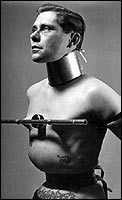
-
The Myth of the Modern Primitive: Emulation and Idolization
Written by
Counterpoint by Blake of Nomad
"A ritual can be described as the enactment of a myth. By participating in a good, sound ritual, you are actually experiencing a mythological life, and it's out of this that one can learn to live spiritually."
– Joseph CampbellThe myth of the Modern Primitive — a term coined by Fakir Musafar some twenty years ago when the body modification movement was in its infancy — is now applied broadly to anyone whose personal modification can be traced to an existing (or once existing) ancient or primitive culture; a tribal tattoo or a stretched earlobe for example.
Emulation or idolization, as Shannon suggests, can imply a mindless “because-it’s-cool” mentality — one based merely on aesthetic admiration. While anyone who can see must respect a Polynesian tattooed full body suit or the lobes of an elder Dayak, I suggest that the inclination toward tribal body modification transcends cultural barriers.
To refer to primitive cultures in general as “brutal and repressive” (does our own regime not brutally repress other societies around the world?) is to ignore the fact that these cultures, despite their “unsophisticated sociological moral structures” (a Western judgment according to Eurocentric ideals) prevailed for, in many cases, thousands of years. The reign of our Western society, a mere two centuries, is a drop in the bucket of time when compared with, for example, Egyptian dynasties that lasted over 3,000 years, did not destroy their environment, and left a legacy of architecture, high culture, art, jewelry, and demonstrated mastery over geometry. Recent archaeological evidence suggests that the labor force that constructed the great pyramids was well cared for — after all, a hungry worker gets little done. A vast network of modest domiciles, marketplaces, shops, even brothels and wine cellars tell us that although people died, the Pharaoh’s workforce was well organized, well rested, and drank, ate, and got laid.
The success of any civilization historically has depended on a social hierarchy, political or military infrastructure, and a spiritual, ritualistic, or religious dogma enacted by those “closest to the Gods”. Traditionally, tattoos and piercings were incorporates of that spiritual and social fabric. In Egyptian culture (the example I am using here), contrary to what Shannon suggests, it was primarily the upper-class who were tattooed and pierced.
The propaganda, mind control, and military threat utilized by the Nazi party affected societal control in a way much different than Aztec priests offering human sacrifice. Although prisoners of war were sacrificed, there was also an entire order of people who were offered consensually. In fact, these people were revered and considered it a high honor to have their blood and themselves offered to the Gods. Today, our own government utilizes many of Hitler’s principals of power (military threat, economic sanctions, propaganda, etc.) but “human sacrifice” no longer has the context of ritual and the spirit world. War is brutally and arbitrarily effected with technology and sophisticated weaponry (war is a timeless human motif; ancient or contemporary)… we need not even look our enemy in the eye.
I believe today’s “Modern Primitive” rarely supposes these “rituals (profound) and modifications (beautiful)” to be true expressions to aspire to of the romanticized “noble savage”. Rather, the primary reasoning for modern people to modify their bodies in a primitive fashion has more to do with aesthetics than rituals; an innate genetic predisposition of all humans. Modern people have the same human inclination as the primitive tribesman.
Author’s Note
A reminder that Anglo-Europeans also have a tribal heritage. Although we have been disassociated from it for over a thousand years, it is still our history as well.
I am a self-educated anthropologist, and piercer primarily of Italian descent. The oldest human mummy known to science and archaeology is a bronze-age man found on the Italian side of the Swiss Alps. He had over seventy black “tribal” tattoos, corresponding to chinese meridian points (acupuncture) and a healthy pair of 5/8″ stretched earlobes!
DNA profiling found that he had living relatives in Italy today. That’s my people! Not the mindless caveman you’d think for 6,000 years ago! More on that in my book (scroll down to the bottom for more information).
It is our societal context, lack of ritualistic format, and our disassociation from our own tribal past that is the difference. With self-education and practice we can rediscover these things.
It is more than curious to me that cultures separated by time and geography practiced nearly identical forms of body modification. In fact, the stretched earlobe is the single most prevalent and occurring form of body modification in human history (I will spare the reader by not listing those cultures here). This suggests a deeper intuition that transcends race and culture. The act of “taking control”, as Shannon suggests, is in fact a human necessity.
I don’t think it is possible to presuppose or describe simply people’s motivation to self-decorate and modify. In a society nearly devoid of ritual, the 18th birthday navel piercing and mini-tribal tattoo is a modern Western-derived rite of passage. It is not one handed down by our elders, but a newly reinvented one (because tribal drives are still buried inside the genetic memory of the suburban American girl), and one with valuable social and even spiritual potential.
Spirituality is very much about transcendence (of fear of pain, of social stigmas, and so on) and in any capacity is a deeply personal experience (even if we cannot articulate its meaning)… if it happens at all.
It is an ironic juxtaposition indeed that the “underground subculture of the Modern Primitive” is a “system (self)sustaining” within mainstream society. This society whose premise of conformity and normality omit modifying the body altogether as social necessity — one of conformity and “sustaining the group” above all else — is the mainstream of unmodified individuals! The evolution of the individual, I agree, must again take precedence over that of sustaining the society because as a society, we are fractured and subdivided (the tribal connection to our collective human past has the potential to bond all of us together). Individual freethinkers must again step into the limelight of humanity to save us from ourselves.
With any mass-produced cultural product (religion, pop music, body jewelry, or a government-engineered ignorant society) the potential for transformative experience is reduced to a simple mathematical equation — percent and ratio. There will always be a few fortunate individuals within the group who will delve deeper and due to early conditioning, personal experiences, acquired knowledge, and individual constitution gain far more than the “mindless masses” from their transformations. The “thick fog of fashion” pervades every aspect of adornment, regardless of time in history or civilization. Our own ignorance (culturally and collectively) is ultimately all that will damage body modifications’s ability to enlighten. Again it comes down to the individual.
Fuck the group. Know yourself and then relate to those who are like-minded and God forbid a few of you hang out and become a group… at least in “my group” everyone designed their own tattoos….
In a global society another strange juxtaposition of culture has occurred. Many tribal people now emulate and idolize tattoos of the West. On a trip through the rain forests of Central America with my wife two years ago, in the middle of nowhere, at a small stand by the side of the road, we got out to stretch our legs. Several heavily tattooed midgets of mixed Spanish-Mayan descent came out of the woodwork to check me out. They were covered with images of Elvis, skulls and crossbones, daggers, pinup girls and WWII airplanes. And there I was with my “tribal” body suit (all of my designs derived from dreams and vision quests marking significant times of my life). We checked each other out, shook hands and smiled a lot… a certain unspoken understanding had transpired. In an age of cross-cultural-trans-global-sociological influence, who was emulating and idolizing who? It no longer matters.
I AM GOD
Be God, create beyond yourself
reject the placebos of everyone else
wash and melt from your unconscious, slumbering mind
and depart from the life-eating lull of the grind.
Smash and remake
rebuild and design
unlearn from the core
then extend to outside
your chosen, ethereal, and leaving you blind
id-image-synaptic
as seen through your eyes.
…..BLAKE
PS. Shannon’s thoughts on corporations and craftsmen I am in agreement with, as well as his advice on the ways one might obtain a meaningful tattoo (avoiding fllash). If you want the same tattoo every Joe has — you know, that one on the wall — why bother? However, if that Tasmanian Devil has deep personal meaning for you, then you did choose the right tattoo.
 Blake’s book, A Brief History of the Evolution of Body Adornment in Western Culture: Ancient Origins and Today is available from his website, nomadmuseum.com, and will be added to the media section of BMEshop shortly for online ordering. Fakir Musafar writes that this 150-page oversize book is a “must have” for all serious modifiers.
Blake’s book, A Brief History of the Evolution of Body Adornment in Western Culture: Ancient Origins and Today is available from his website, nomadmuseum.com, and will be added to the media section of BMEshop shortly for online ordering. Fakir Musafar writes that this 150-page oversize book is a “must have” for all serious modifiers. The grandson of dental surgeon, noted socialite, and traveller Dr. Naomi Coval, Blake Andrew Perlingieri was inspired by his grandmother’s travels to remote tribal areas in the early to middle parts of the 20th century.
The grandson of dental surgeon, noted socialite, and traveller Dr. Naomi Coval, Blake Andrew Perlingieri was inspired by his grandmother’s travels to remote tribal areas in the early to middle parts of the 20th century.Professionally, Blake began his carreer in 1990 at San Francisco’s premier piercing studio, Body Manipulations. At this time the only other studio was Gauntlet, L.A.. In 1993, Blake and his former partner, Kristian White, opened Nomad, the first tribal studio in the industry. Blake and Nomad have been featured numerous times in Fakir’s Body Play and all of the early publications and TV media of the day. In 1995, Nomad opened Australia’s first piercing studio in Melbourne. From 1996 to 1998 Blake brought his tribal gospel to the east coast and operated Venus with Maria.
In 1998, Blake returned west to open as sole proprietor Nomad Precision Body Adornment and Tribal Art Museum. Combining his famous jewelry collection with his recently inherited grandmother’s tribal art, Blake seeks to educate the children of the future, raise awareness about endangered tribes, and provide a cultural and educational context to body adornment for modern people.
The photo on the right was taken by Fakir Musafar.
Copyright © 2003 BMEZINE.COM. Requests to republish must be confirmed in writing. For bibliographical purposes this article was first published July 27, 2003 by BMEZINE.COM in Tweed, Ontario, Canada.
-
The Myth of the Modern Primitive: Emulation and Idolization [Guest Column]
Written by

The Myth of the Modern Primitive:
Emulation and IdolizationCounterpoint by Blake of Nomad
"A ritual can be described as the enactment of a myth. By participating in a good, sound ritual, you are actually experiencing a mythological life, and it's out of this that one can learn to live spiritually."– Joseph Campbell
